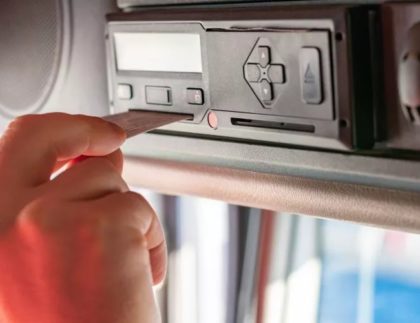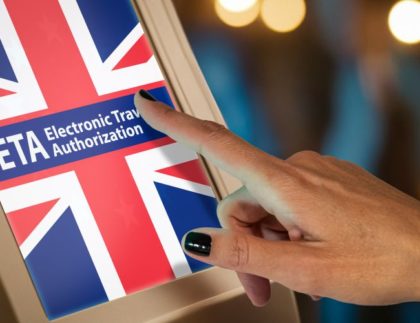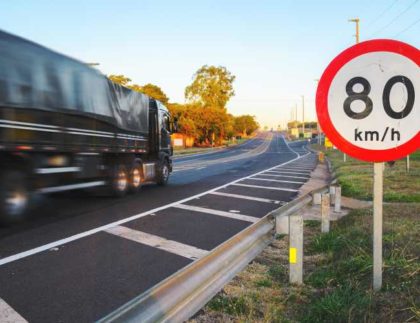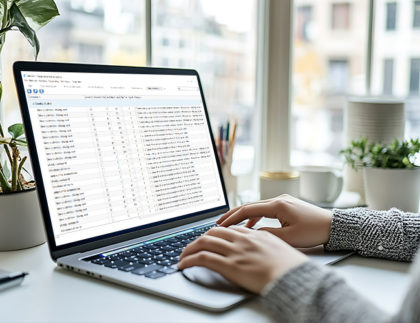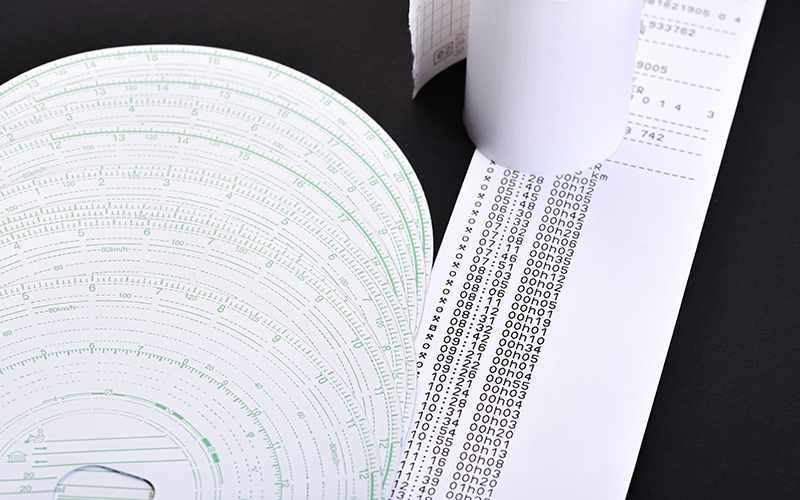

A tachograph is one of the most important vehicle equipment components for a professional driver. It is recommended to stay up to date with all the rules regarding the operation of this device, since any mistakes or misuse may result in high penalties from competent authorities. In order to determine whether any violations have occurred, inspectors may request to review the driver’s working and rest time data, as well as analyze the information recorded against the background of the applicable regulations.
In today’s article, we will discuss the exceptional situations in which a driver can extend their working hours. Find out how to label a tachograph printout and learn about the current legal requirements. Enjoy reading!
What is a tachograph and what is it used for?
A tachograph is a measurement device that records key data about a driver’s activity (driving, on-call or rest time) and information about the operation of the vehicle, such as the distance traveled or the speed achieved. Tachographs are used as part of the efforts to improve traffic safety and counteract driver’s working time abuse.
What are second-generation smart tachographs?
Mandatory use of second-generation smart tachographs – G2V2 has been the hot topic in the TFL industry for many months. Time for replacing your devices is running out – according to the regulations, by 18 August 2025, new tachographs must be installed in all trucks with a permissible total weight over 3.5 tons, as well as buses used in international transport within the European Union.
New features of smart tachographs include automatic recording of border crossings, as well as recording the loading/unloading time and position, as well as the type of carriage. Another significant change allows inspection authorities to remotely read data from vehicles in motion using the DSRC technology.
What are the types of tachograph printouts?
Before you learn how to label a tachograph printout, it is useful to determine when is this necessary and what types of printouts are available. We can specify the following printouts:
- daily printout from the driver’s card;
- events and interference from the driver’s card;
- daily printout from the vehicle;
- events and interference from the vehicle;
- technical data;
A printout from the tachograph is required for example for a roadside inspection, when driving time was exceeded or a rest period was shortened (i.e. invoking Article 12/561/EC/2006, discussed below), and the loss or destruction of the driver’s card (in such case remember a printout from the tachograph is required both at the beginning and at the end of the route).
How to avoid a penalty for violations?
The driver must be properly trained in the use of the tachograph and the current regulations that they must comply with. This is undoubtedly the best way to reduce the number of violations and related fines; however, it is evident that unforeseen circumstances tend to occur in transportation, including those that may prevent compliance with applicable requirements.
Fortunately, the legislator has left a loophole that often allows the driver to get out of this type of situation unscathed. This is, of course, Article 12/561/EC/2006.
What are the provisions of Article 12/561/2006 EC?
This is the context where doubts arise as to how to label a tachograph printout after exceeding the driving time. Article 12 of Regulation 561/2006 states that compliance with the regulations can be waived under certain strictly defined circumstances. The regulation states that:
- “Provided that road safety is not thereby jeopardized and to enable the vehicle to reach a suitable stopping place, the driver may depart from Articles 6 to 9 to the extent necessary to ensure the safety of persons, of the vehicle or its load. The driver shall indicate the reason for such departure manually on the record sheet of the recording equipment or on a printout from the recording equipment or in the duty roster, at the latest on arrival at the suitable stopping place.”
The aforementioned Articles 6–9 concern daily and weekly driving time (Article 6), driving breaks (Article 7), daily and weekly rest periods (Article 8), as well as time spent by the driver on a ferry or train (Article 9).
The Regulation further states that in exceptional circumstances it is possible to exceed driving time – on a weekly basis, it is allowed to exceed daily and weekly driving time by up to one hour in order to reach the company’s operations center or place of residence (to use the weekly rest period).
Under the same rules, a driver may exceed their daily and weekly driving time by two hours (provided a 30-minute break is used immediately before the additional driving period).
How to correctly label a tachograph printout after exceeding driving time?
It should be noted that it is not always possible to take advantage of driving time extension exemptions. The description of the situation causing this need must indicate that the circumstances objectively prevented the driver from complying with regulations. These should be unpredictable situations, such as a traffic jam caused by a road accident, delays caused by weather conditions, lack of parking spaces or the need to secure property.
The driver should draft a description immediately, upon reaching the first place that allows for a safe stop. Tachograph printouts must be retained for 28 days.
What should be written on the back of the tachograph printout?
A detailed description of the situation should be provided on the back. This description should include information on the time, place, type and cause of the offense. The driver should invoke Article 12/561/2006 EC, sign the printout and specify by how much they exceeded their working hours or shortened their rest period.





